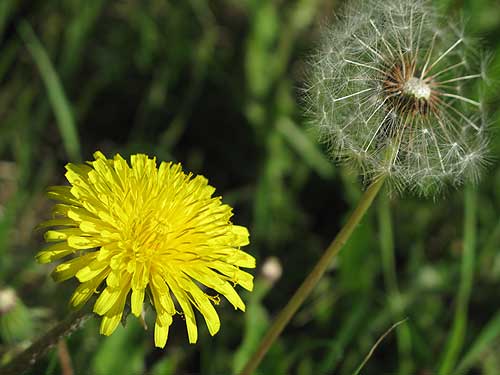 Sun stands still on Saturday
solstice
Sun stands still on Saturday
solstice
By NED ROZELL
June 17, 2009
Wednesday
"Did you feel it?" a friend asked on June 20th, at
about 9:45 p.m. on a sunny Alaska night.
No, it wasn't another earthquake. At that moment, the sun paused
on its journey around our northern horizon, and we, for a second
or two, experienced summer solstice.
Solstice is the precise time when the top of the world nods deepest
toward the sun. Here's what it's like when solstice (a word derived
from Latin words meaning "sun standing still") arrives
in Alaska:
Darkness, our old friend, has vanished. Even in Southeast, a
person can read a book outside at midnight without a headlamp.
Forget the aurora; it's still there, dancing in the upper atmosphere,
but we can't see it. Stars, too, are a memory.
 High summer is here
in Alaska.
High summer is here
in Alaska.
Photo by Ned Rozell
Male songbirds fill the forests with melody. Mother birds warm
millions of little eggs, in nests from Attu to Annette. Alaska
is bursting with migrants, here to exploit one of the richest
populations of insects on the planet. Ravens, chickadees, and
other winter comrades share the boom.
Alaska creatures that depend on darkness-little brown bats, flying
squirrels, and owls-somehow make a go of it when rays of sunlight
illuminate their roosts at 11 p.m. Perhaps more appreciative
of the constant light are the millions of salmon shooting upstream
like fading torpedoes. When they stop, they will mate and die,
their bodies enriching water, soil, bird and mammal.
All that solar radiation striking the tundra, the trees, the
pavement and the people has a profound effect. Plants grow with
such speed that gardeners wish they had photographed the tomato
stems each day, because they swear they are six inches taller.
Those gardeners savor the sun on their skin, which converts sunlight
to vitamin D, which will show up in their bloodstreams in one
month.
Glaciers flood their gravel arteries with meltwater, surging
in the afternoon and relaxing at night and early morning. They
are shedding last winter's snowfall, and some are now losing
blue ice that fell as snow hundreds of years ago, during a cold
period called the Little Ice Age.
The solstice warmth is penetrating the ground, thawing the soil
that froze last fall and winter. As the summer progresses, the
heat will slowly penetrate to its maximum depth, sometimes thawing
permafrost-ground that had remained frozen through the heat of
at least two summers-another relic of a very cold time gone by.
The sea ice floating like a jigsaw puzzle on the Arctic Ocean
is now on the wane. Non-stop sunlight melts it and warms the
water around it, causing more ice to melt. But if you want to
sneak through the Northwest Passage in your dinghy, solstice
is not the time to try. The icepack won't shrink to its minimum
until mid-September.
Now is a time you might smell molecules of singed aspen and black
spruce, a nostalgic scent that tells you a forest fire is consuming
part of Alaska. Each year, about 10 times more land in Alaska
burns than in any other state; in 2004, an area the size of Vermont
burned, and, with its brownish haze, Alaska looked a bit like
Beijing.
Alaskans hope to avoid a repeat of that year, but all our solstice
sunshine encourages the development of cumulonimbus clouds, which
give birth to lightning strikes. On a day with fertile conditions,
the flammable surface of Alaska can receive more than 7,000 hits
from lightning. Some of those do nothing but char tundra; some
strike tinder-dry trees that burst into flames and inspire the
growth of a mushroom cloud.
As many of you are reading this, summer solstice has passed.
The northland has begun its tilt toward the other solstice, six
months from now, a time when the Alaska sun peeks rather than
soars over the horizon, providing less sensation on your skin
than the tickle of an ant in midsummer.
This column is provided
as a public service by the Geophysical
Institute,
University of Alaska Fairbanks, in cooperation with the UAF
research community.
Ned Rozell [nrozell@gi.alaska.edu]
is a science writer at the institute.
E-mail your news &
photos to editor@sitnews.us
Publish A Letter in SitNews Read Letters/Opinions
Contact the Editor
SitNews
©2009
Stories In The News
Ketchikan, Alaska
|

